Original URL: https://www.theregister.com/2007/06/29/ft_newton_messagepad/
Apple's first handheld: the Newton MessagePad
Posted in Personal Tech, 29th June 2007 11:14 GMT
Forgotten Tech Some say the apple doesn't fall far from the tree and when you consider the history of the PDA, that statement holds many truths.
While the iPhone looks set to take the market by storm, the HTC S620 and Samsung i600 were good takes on the Blackberry, and the Palm Treo range has long been tested and trusted. The Treo's roots lie in Palm's original Pilot, a product category HP's iPaq range later smartened up.
But all these gadgets have one thing in common: they base their capabilities and concept on the godfather of PDAs. Although sluggish and bulky by today's standards, the device helped set the tone for PDAs to come.
It was, of course, Apple's Newton MessagePad. Born in August 1993, the MessagePad was first unveiled at MacWorld Boston and was priced at around $699.
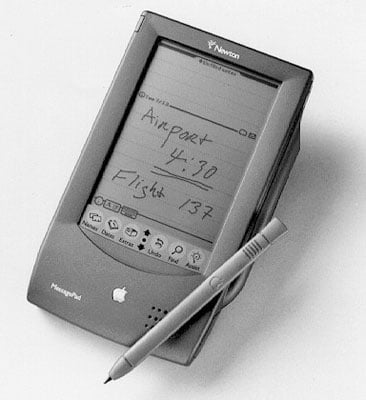
The first Apple MessagePad
The device was a revolution in personal computing, helping to create a whole new world of mobile working. Well, if you believed Apple's hype, it would. Although commonly referred to as the Newton, this was actually the MessagePad's operating system.
The first MessagePads were manufactured by Sharp Electronics - Sharp even released its own version of the product, the ExpertPad - and featured large, bright and clear 336 x 240 LCD screens, though sadly never in colour. Some early models did feature golden coloured screens, something which many fans were sad to lose when Apple later switched manufacturers.
The main body of the MessagePad was also often encased in rubberised plastic, but after heavy use tended to flake or peel and so was later dropped as a feature by Apple.
At its core, the first MessagePads were relatively sophisticated for the time. The 100 - Apple's second MessagePad, introduced in March 1994 - used a 20MHz ARM processor, alongside 640KB RAM. The last MessagePad, the 2100, introduced in November 1997, had a 162MHz processor and included 8MB of memory - 4MB of Ram and 4MB of Flash. By this point, the screen had grown to 320 x 480 but could only show 16 shades of grey.
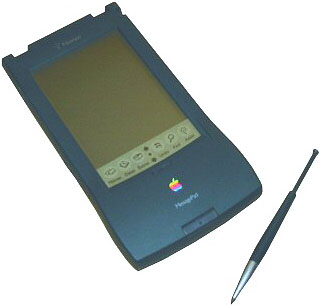
Apple's second-gen MessagePad, the 110
For many this was of little significance, because the MessagePad meant something else. It meant people no longer had to be tied to their desks in order to perform computing tasks.
The MessagePad's unique selling point was its ability to capture handwriting onto its touch-sensitive screen using a stylus - which some fans dubbed 'the carpenter's knife'.
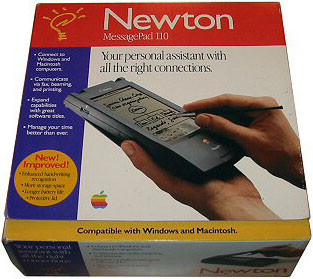
The MessagePad 110 box
Apple's handwriting recognition technology was called Calligrapher. While quite advanced for its time, it was frequently lampooned by the media for its constant inability to recognise handwriting, especially in cursive form.
Even The Simpsons got in on the joke, sketching out a scene where a MessagePad was used to store the memo "Beat up Martin", but which was interpreted as "Eat up Martha". The Doonesbury comic strip also poked fun at the MessagePad's iffy handwriting recognition as well, much to the annoyance of Apple.
In an everyday setting, the MessagePad was seen as a pretty cutting edge device, though. For example, the user could write "Dinner with Laura tomorrow" onto its screen and then tap on the Assist button, which would - depending on Newton's interpretation of the text - open a meeting slip already completed and showing the last-accessed person named Laura, tomorrow's date and the time allocated to the meeting.
The MessagePad had its rivals, of course. Perhaps the most notable was the Palm Pilot, which used a different, character-by-character text recognition technology that, although more difficult to learn, proved to be more accurate at recognising user's input.

The MessagePad lampooned by Gary Trudeau
Amazingly, a Gary Trudeau cartoon was incorporated as an Easter Egg into Newton OS 2.0.
The MessagePad was still hugely successful for Apple though, with around seven models of the handset developed between 1993 and 1998, together with several different versions of the Newton OS as well, from 1.0 to 2.1.
The Newton OS had many strings to its bow, including fax and email capabilities. The Notes application allowed users to store information such as memos, checklists or to-do lists. Although initially fairly basic, Newton OS 2.0 was refined to allow users to bullet-point notes and develop "trees" - a string of related memos.
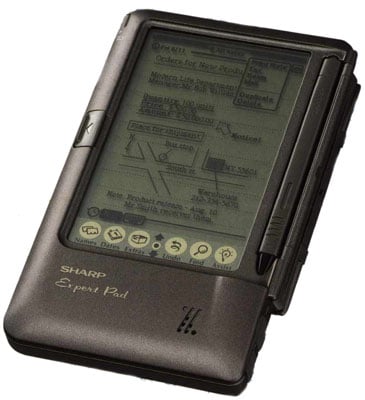
Newton licensed: Sharp's ExpertPad
Names was developed for storing contact details. A nice feature, present even on most basic mobile phones today, was that Newton would automatically make the entry of a birthday a recurring event, ensuring you never had an excuse to forget that gift.
Present-day PDAs and mobiles also still feature many of Newton's additional applications, all of which were accessed through Newton's GUI, such as an In Box, Out Box, Clock, Calculator and find facility.
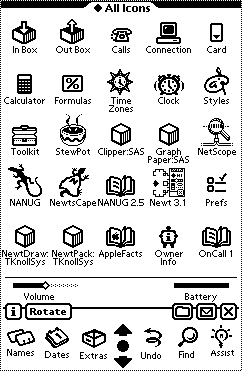
The MessagePad's Newton GUI
Of course, all this information meant Apple needed to develop a way for the MessagePad to store data, and this came in the form of Newton "soups" - freeform databases that could be accessed by all of the MessagePad's applications. Each application had its own soup, but each soup was also accessible by other applications, meaning notes, memos, the address book, etc could all cross-reference data stored in other soups.
While the soup structure was undoubtedly a sophisticated method of storing information, it ultimately meant that those using the MessagePad as a compliment to a PC weren't able to synchronise data between the two, because each used different data storage structures.
Apple did ensure though that the MessagePad had an edge over rivals in its ability to allow users to connect. All models featured infrared and had a PCMCIA slot to allow Flash cards, and wireless adaptors to be added.
Battery life was always a mood point on most models though. The three AAA-powered MessagePad and MessagePad 100 could manage 14 hours' runtime. The upgraded MessagePads 110 and 130 used four AA batteries - not good for the device's size and weight, but did give the MessagePad around 24 hours of use.
All the MessagePad models were significantly larger than PDAs on the market today. The original MessagePad was 18.4 x 11.3 and 1.9cm and weighed 408g. The second-gen design of the MessagePad 110 upped the weight to 581g and the size to 20 x 10 x 3.1cm.
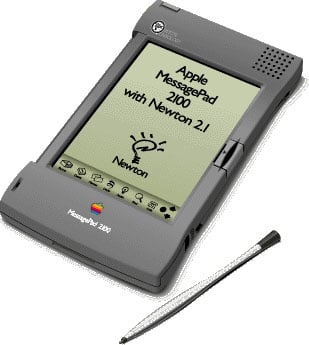
Apple's last MessagePad, the 2100
The MessagePad 2100 was larger and bulkier still, measuring 27.5cm x 11.9 x 2.1cm, while weighing 640g.
For most of the MessagePad's life, Apple sought to market it as a device that could reinvent the computing methods of the time. This ultimately proved an impossible task, and Apple attempted to reposition the device more as a mobile adjunct to a Mac - something the Palm Pilot was successfully doing in the PC world.
Apple's awakening came too late, and combined with Newton's poor handwriting recognition, the high cost and the MessagePad's large size, the death knell of the first PDA was sounded in February 1998.
More Forgotten Tech...
• 15 years ago: the first mass-produced GSM phone
• Compact Disc: 25 years old today
• From 1981: the World's first UMPC
• The IBM ThinkPad: 15 years old today
• Atari's Portfolio: the world's first palmtop
• 'Timna' - Intel's first system-on-a-chip
• BeOS: the Mac OS X might-have-been
• Sony's first Mylo